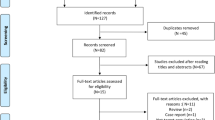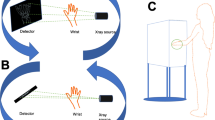Abstract
Objective
This prospective study investigated the sensitivity of cone beam computed tomography (CBCT), a low dose technique recently made available for extremity examinations, in detecting scaphoid fractures. Magnetic resonance imaging (MRI) was used as gold standard for scaphoid fractures.
Materials and methods
A total of 95 patients with a clinically suspected scaphoid fracture were examined with radiography and CBCT in the acute setting. A negative CBCT exam was followed by an MRI within 2 weeks. When a scaphoid fracture was detected on MRI a new CBCT was performed.
Results
Radiography depicted seven scaphoid fractures, all of which were also seen with CBCT. CBCT detected another four scaphoid fractures. With MRI another five scaphoid fractures were identified that were not seen with radiography or with CBCT. These were also not visible on the reexamination CBCT. Sensitivity for radiography was 44, 95 % confidence interval 21–69 %, and for CBCT 69 %, 95 % confidence interval 41–88 % (p = 0.12). Several non-scaphoid fractures in the carpal region were identified, radiography and CBCT depicted 7 and 34, respectively (p < 0.0001).
Conclusion
CBCT is a superior alternative to radiography, entailing more accurate diagnoses of carpal region fractures, and thereby requiring fewer follow-up MRI examinations. However, CBCT cannot be used to exclude scaphoid fractures, since MRI identified additional occult scaphoid fractures.







Similar content being viewed by others
References
Smith M, Bain GI, Turner PC, Watts AC. Review of imaging of scaphoid fractures. ANZ J Surg. 2010;80(1–2):82–90.
McCullough NP, Smith FW, Cooper JG. Early MRI in the management of the clinical scaphoid fracture. Eur J Emerg Med. 2011;18(3):133–6.
Hunter JC, Escobedo EM, Wilson AJ, Hanel DP, Zink-Brody GC, Mann FA. MR imaging of clinically suspected scaphoid fractures. AJR Am J Roentgenol. 1997;168(5):1287–93.
Jenkins PJ, Slade K, Huntley JS, Robinson CM. A comparative analysis of the accuracy, diagnostic uncertainty and cost of imaging modalities in suspected scaphoid fractures. Injury. 2008;39(7):768–74.
Jorgsholm P, Thomsen NO, Besjakov J, Abrahamsson SO, Bjorkman A. The benefit of magnetic resonance imaging for patients with posttraumatic radial wrist tenderness. J Hand Surg [Am]. 2013;38(1):29–33.
Reigstad O, Grimsgaard C, Thorkildsen R, Reigstad A, Rokkum M. Scaphoid non-unions, where do they come from? The epidemiology and initial presentation of 270 scaphoid non-unions. J Hand Surg. 2012;17(3):331–5.
Herbert TJ, Fisher WE. Management of the fractured scaphoid using a new bone screw. J Bone Joint Surg (Br). 1984;66(1):114–23.
Bruno M. ACR Appropriateness Criteria®: acute hand and wrist trauma
De Zwart AD, Beeres FJ, Ring D, Kingma LM, Coerkamp EG, Meylaerts SA, et al. MRI as a reference standard for suspected scaphoid fractures. Br J Radiol. 2012;85(1016):1098–101.
Yin ZG, Zhang JB, Kan SL, Wang XG. Diagnosing suspected scaphoid fractures: a systematic review and meta-analysis. Clin Orthop Relat Res. 2010;468(3):723–34.
Yin ZG, Zhang JB, Kan SL, Wang XG. Diagnostic accuracy of imaging modalities for suspected scaphoid fractures: meta-analysis combined with latent class analysis. J Bone Joint Surg (Br). 2012;94(8):1077–85.
Mallee W, Doornberg JN, Ring D, van Dijk CN, Maas M, Goslings JC. Comparison of CT and MRI for diagnosis of suspected scaphoid fractures. J Bone Joint Surg Am. 2011;93(1):20–8.
Memarsadeghi M, Breitenseher MJ, Schaefer-Prokop C, Weber M, Aldrian S, Gabler C, et al. Occult scaphoid fractures: comparison of multidetector CT and MR imaging—initial experience. Radiology. 2006;240(1):169–76.
Scarfe WC, Farman AG. What is cone-beam CT and how does it work? Dent Clin North Am. 2008;52(4):707–730.
Carrino JA, Al Muhit A, Zbijewski W, Thawait GK, Stayman JW, Packard N, et al. Dedicated cone-beam CT system for extremity imaging. Radiology. 2014;270(3):816–24.
De Cock J, Mermuys K, Goubau J, Van Petegem S, Houthoofd B, Casselman JW. Cone-beam computed tomography: a new low dose, high resolution imaging technique of the wrist, presentation of three cases with technique. Skeletal Radiol. 2012;41(1):93–6.
Faccioli N, Foti G, Barillari M, Atzei A, Mucelli RP. Finger fractures imaging: accuracy of cone-beam computed tomography and multislice computed tomography. Skeletal Radiol. 2010;39(11):1087–95.
Ramdhian-Wihlm R, Le Minor JM, Schmittbuhl M, Jeantroux J, Mahon PM, Veillon F, et al. Cone-beam computed tomography arthrography: an innovative modality for the evaluation of wrist ligament and cartilage injuries. Skeletal Radiol. 2012;41(8):963–9.
Koivisto J, Kiljunen T, Wolff J, Kortesniemi M. Assessment of effective radiation dose of an extremity CBCT, MSCT and conventional X ray for knee area using MOSFET dosemeters. Radiat Prot Dosimetry. 2013;157(4):515–24.
Koskinen SK, Haapamaki VV, Salo J, Lindfors NC, Kortesniemi M, Seppala L, et al. CT arthrography of the wrist using a novel, mobile, dedicated extremity cone-beam CT (CBCT). Skeletal Radiol. 2013;42(5):649–57.
Biswas D, Bible JE, Bohan M, Simpson AK, Whang PG, Grauer JN. Radiation exposure from musculoskeletal computerized tomographic scans. J Bone Joint Surg Am. 2009;91(8):1882–9.
Huda W, Gkanatsios NA. Radiation dosimetry for extremity radiographs. Health Phys. 1998;75(5):492–9.
Taljanovic MS, Karantanas A, Griffith JF, DeSilva GL, Rieke JD, Sheppard JE. Imaging and treatment of scaphoid fractures and their complications. Semin Musculoskelet Radiol. 2012;16(2):159–73.
Mallee WH, Doornberg JN, Ring D, Maas M, Muhl M, van Dijk CN, et al. Computed tomography for suspected scaphoid fractures: comparison of reformations in the plane of the wrist versus the long axis of the scaphoid. Hand (N Y). 2014;9(1):117–21.
Brydie A, Raby N. Early MRI in the management of clinical scaphoid fracture. Br J Radiol. 2003;76(905):296–300.
Murthy NS. The role of magnetic resonance imaging in scaphoid fractures. J Hand Surg [Am]. 2013;38(10):2047–54.
Cruickshank J, Meakin A, Breadmore R, Mitchell D, Pincus S, Hughes T, et al. Early computerized tomography accurately determines the presence or absence of scaphoid and other fractures. Emerg Med Australas. 2007;19(3):223–8.
Tiel-van Buul MM, van Beek EJ, Broekhuizen AH, Nooitgedacht EA, Davids PH, Bakker AJ. Diagnosing scaphoid fractures: radiographs cannot be used as a gold standard! Injury. 1992;23(2):77–9.
Author information
Authors and Affiliations
Corresponding author
Ethics declarations
Conflict of interest
The authors declare that they have no conflict of interest.
Rights and permissions
About this article
Cite this article
Edlund, R., Skorpil, M., Lapidus, G. et al. Cone-Beam CT in diagnosis of scaphoid fractures. Skeletal Radiol 45, 197–204 (2016). https://doi.org/10.1007/s00256-015-2290-6
Received:
Revised:
Accepted:
Published:
Issue Date:
DOI: https://doi.org/10.1007/s00256-015-2290-6




